In the ever-evolving digital landscape, optimizing ad campaigns is crucial for achieving marketing success. Social media marketing platforms have become integral tools in this optimization process. By harnessing their capabilities, businesses can enhance their ad performance, target audiences more effectively, and maximize ROI. This blog post delves into how social media marketing platforms can optimize ad campaigns, offering insights and strategies to help businesses make the most of these powerful tools.
Table of Contents
- Understanding Social Media Marketing Platforms
- Benefits of Social Media Marketing Platforms
- Strategies for Optimizing Ad Campaigns
- Define Clear Objectives
- Target the Right Audience
- Leverage Data Analytics
- Test and Optimize Ad Creatives
- Measuring Campaign Success
Understanding Social Media Marketing Platforms
Social media marketing platforms refer to online tools and services designed to help businesses promote their products and services across various social media channels. Platforms such as Facebook Ads, Instagram Ads, LinkedIn Ads, and Twitter Ads are prominent examples. These platforms offer a range of features and targeting options that enable advertisers to reach specific audiences and achieve their marketing goals.
By utilizing these platforms, businesses can create targeted ad campaigns that are tailored to their audience’s interests, behaviors, and demographics. The versatility and granularity of these tools make them indispensable for optimizing ad campaigns and driving better results.
Benefits of Social Media Marketing Platforms
Social media marketing platforms offer several benefits that contribute to the successful optimization of ad campaigns. Here are some key advantages:
- Precise Targeting: These platforms provide advanced targeting options, allowing advertisers to reach specific audience segments based on factors such as age and location. Additionally, targeting can be refined further by considering interests and behavior..
- Cost-Effectiveness: Social media platforms often offer flexible pricing models, enabling businesses to control their ad spend and achieve better cost-per-acquisition rates.
- Real-Time Analytics: Advertisers can access real-time data on ad performance, enabling them to make informed decisions. Additionally, this data allows for adjustments to strategies as needed.
- Enhanced Engagement: Social media ads have the potential to generate higher engagement rates, including likes, shares, and comments, which can amplify the reach of the campaign.
Strategies for Optimizing Ad Campaigns
To fully leverage social media marketing platforms, businesses should implement effective strategies to optimize their ad campaigns. Here are some proven approaches:
Define Clear Objectives
Before launching an ad campaign, it is essential to define clear objectives. Objectives might include increasing brand awareness, driving website traffic, or generating leads. By setting specific, measurable, achievable, relevant, and time-bound (SMART) goals, businesses can better align their ad strategies with their overall marketing objectives.
Target the Right Audience
Targeting the right audience is crucial for maximizing the effectiveness of ad campaigns. Social media marketing platforms offer sophisticated targeting options that allow advertisers to reach users based on their demographics, interests, and behaviors. By refining audience targeting, businesses can ensure that their ads are seen by those most likely to be interested in their products or services.
Leverage Data Analytics
Data analytics play a vital role in optimizing ad campaigns. Social media marketing platforms provide valuable insights into ad performance, including metrics such as click-through rates, conversion rates and engagement levels. By analyzing this data, businesses can identify trends, understand what works, and make data-driven adjustments to improve campaign performance.
Test and Optimize Ad Creatives
Testing and optimizing ad creatives is an ongoing process that can significantly impact campaign success. A/B testing, for example, allows businesses to compare different versions of an ad to determine which performs better. By continuously testing various elements, such as headlines, images, and calls-to-action, businesses can identify the most effective combinations and refine their ad creatives for optimal results.
Measuring Campaign Success
Measuring the success of ad campaigns is essential for understanding their impact and making informed decisions. Social media marketing tools provide a range of metrics and reporting tools that can help businesses assess campaign performance. Key performance indicators (KPIs) to consider include:
- Click-Through Rate (CTR): The percentage of users who click on an ad after seeing it.
- Conversion Rate: The percentage of users who complete a desired action, such as making a purchase or signing up for a newsletter.
- Cost Per Click (CPC): The average cost incurred for each click on an ad.
- Return on Ad Spend (ROAS): The revenue generated for every dollar spent on advertising.
By analyzing these metrics, businesses can evaluate the effectiveness of their ad campaigns, identify areas for improvement, and optimize future strategies.
Optimizing ad campaigns with social media marketing tools is a powerful way to enhance marketing performance and achieve business objectives. By understanding the benefits of these platforms, implementing effective strategies, and leveraging data analytics, businesses can drive better results and maximize their return on investment. As the digital landscape continues to evolve, staying informed about the latest trends in social media marketing will be crucial. Additionally, understanding best practices will be essential for ongoing success.
Maximize your marketing impact with Munshify TenaX! Claim your 14-day free trial now and optimize your social media ads effortlessly. Start Your Free Trial


